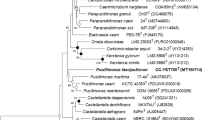Abstract
A polyphasic taxonomic study was carried out on strain EBR-8-1T isolated from a biofilm reactor in Korea. The cells of the strain were Gram-stain negative, non-spore-forming, non-motile, and short rod-shaped. Comparative 16S rRNA gene sequence studies showed a clear affiliation of this strain with Betaproteobacteria, which showed high pairwise sequence similarities with Pusillimonas noertemannii BN9T (99.1 %), Pusillimonas soli MJ07T (97.3 %), Pusillimonas ginsengisoli DCY25T (97.2 %), and Pusillimonas harenae B201T (96.8 %). The phylogenetic analysis based on 16S rRNA gene sequences showed that the strain formed a clear phylogenetic lineage within the genus Pusillimonas. The major fatty acids were identified as C16:0, C17:0 cyclo and C19:0 cyclo ω8c. The major cellular polar lipids were identified as phosphatidylglycerol, diphosphatidylglycerol, phosphatidylethanolamine and an unidentified aminolipid. The respiratory quinone was identified as Q-8 and the genomic DNA G+C content was determined to be 63.3 mol%. On the basis of polyphasic evidence, it is proposed that strain EBR-8-1T should be placed in a new species, Pusillimonas caeni sp. nov. The type stain is EBR-8-1T (=KCTC 42353T = JCM 30463T).

Similar content being viewed by others
References
Brady C, Cleenwerck I, Venter S, Vancanneyt M, Swings J, Coutinho T (2008) Phylogeny and identification of Pantoea species associated with plants, humans and the natural environment based on multilocus sequence analysis (MLSA). Syst Appl Microbiol 31:447–460
Ezaki T, Hashimoto Y, Yabuuchi E (1989) Fluorometric deoxyribonucleic acid- deoxyribonucleic acid hybridization in microdilution wells as an alternative to membrane filter hybridization in which radioisotopes are used to determine genetic relatedness among bacterial strains. Int J Syst Bacteriol 39:224–229
Felsenstein J (1981) Evolutionary trees from DNA sequences: a maximum likelihood approach. J Mol Evol 17:368–376
Felsenstein J (1985) Confidence limit on phylogenies: an approach using the bootstrap. Evolution 39:783–791
Fitch WM (1971) Toward defining the course of evolution: minimum change for a specific tree topology. Syst Zool 20:406–416
Hall TA (1999) Bioedit: a user-friendly biological sequence alignment editor and analysis program for Windows 95/98/NT. Nucleic Acids Symp Ser 41:95–98
Hilyard EJ, Jones-Meehan JM, Spargo BJ, Hill RT (2008) Enrichment, isolation, and phylogenetic identification of polycyclic aromatic hydrocarbon-degrading bacteria from Elizabeth River sediments. Appl Environ Microbiol 74:1176–1182
Jin L, Ko SR, Lee HG, Kim BH, Kim HS, Ahn CY, Oh HM (2014a) Flaviflexus salsibiostraticola sp. nov., an actinobacterium isolated from a biofilm reactor. Int J Syst Evol Microbiol 64:3293–3296
Jin L, Lee HG, La HJ, Ko SR, Ahn CY, Oh HM (2014b) Ferruginibacter profundus sp. nov., a novel member of the family Chitinophagaceae, isolated from freshwater sediment of a reservoir. Antonie Van Leeuwenhoek 106:319–323
Kim OS, Cho YJ, Lee K, Yoon SH, Kim M, Na H, Park SC, Jeon YS, Lee JH et al (2012) Introducing EzTaxon-e: a prokaryotic 16S rRNA gene sequence database with phylotypes that represent uncultured species. Int J Syst Evol Microbiol 62:716–721
Komagata K, Suzuki KI (1987) Lipid and cell wall analysis in bacterial systematics. Methods Microbiol 19:161–207
Lane DJ (1991) 16S/23S rRNA sequencing. In: Stackebrandt E, Goodfellow M (eds) Nucleic acid techniques in bacterial systematics. Wiley, Chichester
Lee M, Woo SG, Chae M, Ten LN (2010) Pusillimonas soli sp. nov., isolated from farm soil. Int J Syst Evol Microbiol 60:2326–2330
Minnikin DE, Patel PV, Alshamaony L, Goodfellow M (1977) Polar lipid composition in the classification of Nocardia and related bacteria. Int J Syst Bacteriol 27:104–117
Park MS, Park YJ, Jung JY, Lee SH, Park W, Lee K, Jeon CO (2011) Pusillimonas harenae sp. nov., isolated from a sandy beach, and emended description of the genus Pusillimonas. Int J Syst Evol Microbiol 61:2901–2906
Saitou N, Nei M (1987) The neighbour-joining method; a new method for reconstructing phylogenetic trees. Mol Biol Evol 4:406–425
Sasser M (1990) Identification of bacteria by gas chromatography of cellular fatty acids. MIDI Technical Note 101. MIDI Inc, Newark
Shapiro OH, Kushmaro A, Brenner A (2010) Bacteriophage predation regulates microbial abundance and diversity in a full-scale bioreactor treating industrial waste water. ISME J 4:327–336
Srinivasan S, Kim MK, Sathiyaraj G, Kim YJ, Yang DC (2010) Pusillimonas ginsengisoli sp. nov., isolated from soil of a ginseng field. Int J Syst Evol Microbiol 60:1783–1787
Stolz A, Bürger S, Kuhm A, Kämpfer P, Busse HJ (2005) Pusillimonas noertemannii gen. nov., sp. nov., a new member of the family Alcaligenaceae that degrades substituted salicylates. Int J Syst Evol Microbiol 55:1077–1081
Tamaoka J, Komagata K (1984) Determination of DNA base composition by reverse-phased high-performance liquid chromatography. FEMS Microbiol Lett 25:125–128
Tamura K, Peterson D, Peterson N, Stecher G, Nei M, Kumar S (2011) mega 5: molecular evolutionary genetics analysis using maximum likelihood, evolutionary distance, and maximum parsimony methods. Mol Biol Evol 28:2731–2739
Tarrand JJ, Groschel DHM (1982) Rapid, modified oxidase test for oxidase-variable bacterial isolates. J Clin Microbiol 16:772–774
Thompson JD, Gibson TJ, Plewniak F, Jeanmougin F, Higgins DG (1997) The clustal x windows interface: flexible strategies for multiple sequence alignment aided by quality analysis tools. Nucleic Acids Res 24:4876–4882
Tindall BJ, Rosselló-Móra R, Busse HJ, Ludwig W, Kämpfer P (2010) Notes on the characterization of prokaryote strains for taxonomic purposes. Int J Syst Evol Microbiol 60:249–266
Wayne LG, Brenner DJ, Colwell RR et al (1987) International committee on systematic bacteriology. Report of the ad hoc committee on reconciliation of approaches to bacterial systematics. Int J Syst Bacteriol 37:463–464
Acknowledgments
This research was supported by Grants from the Advanced Biomass R&D Centre, the Global Frontier Program funded by the Korean Ministry of Science, ICT and Future Planning, the KRIBB Research Initiative Program, and the Priority Academic Program Development of Jiangsu Higher Education Institutions (PAPD).
Author information
Authors and Affiliations
Corresponding authors
Electronic supplementary material
Below is the link to the electronic supplementary material.
Rights and permissions
About this article
Cite this article
Jin, L., Ko, SR., Cui, Y. et al. Pusillimonas caeni sp. nov., isolated from a sludge sample of a biofilm reactor. Antonie van Leeuwenhoek 110, 125–132 (2017). https://doi.org/10.1007/s10482-016-0782-6
Received:
Accepted:
Published:
Issue Date:
DOI: https://doi.org/10.1007/s10482-016-0782-6




